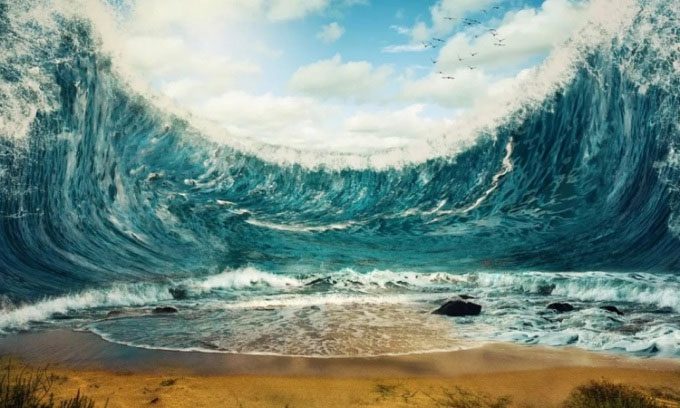Climate Change Could Trigger Massive Tsunamis in the Southern Ocean Through Underwater Landslides in Antarctica.
By drilling sediment cores hundreds of meters deep beneath the Southern Ocean, scientists have discovered that during previous global warming periods, between 3 to 15 million years ago, loose sediment layers formed and collapsed, generating super tsunamis that swept across the coasts of South America, New Zealand, and Southeast Asia. Due to climate change causing ocean warming, the research team suggests that such tsunamis could occur again. They published their findings in the journal Nature Communications, as reported by Live Science on May 24.

Simulation of a tsunami approaching the beach. (Photo: iStock).
“Underwater landslides represent a significant geological risk with the potential to trigger tsunamis that could lead to severe loss of life,” stated Jenny Gales, a lecturer in hydrology and ocean exploration at the University of Plymouth, UK.
The researchers first found evidence of ancient landslides off the coast of Antarctica in 2017 in the eastern Ross Sea. Trapped beneath the landslide debris were weak sediment layers filled with fossils of marine organisms such as plankton. They returned to the area in 2018 and drilled deep into the seabed to collect sediment cores, which are long pillars from Earth’s crust that can reveal the geological history of the area layer by layer.
Through analyzing the sediment cores, the research team discovered that the weak sediment layers formed during two periods: 3 million years ago in the middle of the Pliocene epoch and 15 million years ago in the Miocene epoch. At that time, the waters surrounding Antarctica were over 3 degrees Celsius warmer than today, leading to algal blooms. After dying, these blooms filled the seabed below with slippery, fertile sediment, making the area prone to landslides. According to Robert McKay, director of the Antarctic Research Centre at Victoria University of Wellington, during cooler climate periods and subsequent ice ages, the sediment became buried under thick layers of coarse gravel brought in by glaciers and icebergs.
Researchers are not yet certain about the exact causes that triggered underwater landslides in the past in this region, but they speculate that the most likely cause was the melting of glaciers due to global warming. The end of the ice age caused glaciers to recede and shrink, reducing pressure on Earth’s tectonic plates, leading them to rebound in a process known as isostatic rebound.
Once enough weak sediment layers accumulated, movements of the Antarctic continent triggered earthquakes that caused the coarse gravel layer above the sediment to slide off the continental shelf, resulting in landslides and tsunamis. The scale of ancient tsunamis has not been clearly defined, but scientists have noted two recent underwater landslides that generated massive tsunamis causing severe damage. A 13-meter-high tsunami in the Grand Banks in 1929 resulted in 28 fatalities off the coast of Canada, and a 15-meter-high tsunami in Papua New Guinea claimed the lives of 2,200 people.
With multiple layers of sediment buried beneath the Southern Ocean seabed and glaciers above slowly melting, researchers warn that landslides and tsunamis could reoccur in the future.


















































